Skip to content

 Fire good ones for freedom
Fire good ones for freedom
Only candid champions for freedom and responsibility. Fire B or A quit.
Based on “No Rules Rule of Netflix” shortlisted by Financial Times & McKinsey as a business book of 2020
Star blast pressure
To avoid bankruptcy in 2001 Reed Hastings tried to sell Netflix to the old video rental market leader - Blockbuster. He got rejection. He was desperate: how would Netflix compete with the old giants if there is no investors around for his experiments after dot com bubble. Generally, new companies should not exist. Why not Blockbuster build a new product and up-sell it to its user base at negligible client acquisition costs?
The step to Dense Talent
He had to fire 1/3 of their team. They fired nice guys with adequate performance, pessimistic super performers, less motivated, over motivated hard-workers with poor judgement.
“Morale in the office was low, and it was about to get lower. We had to lay off a third of our workforce,” Hastings says. “We didn’t have any obviously poor performers. So we divided the staff into two piles: the 80 highest performers who we would keep, and 40 less amazing ones”
Fired people were pissed off and slammed doors. Reed expected a backslash from remaining people angry for firing their friends and insecure about their future.
Suddenly, performance soared. He and his teammates started to love to come to work
Netflix realised that “For top performers, a great workplace isn’t about a lavish office, a beautiful gym, or free sushi. It’s about people who can help you be better. When every member is excellent, performance spirals upward as employees learn from and motivate one another.”
Netflix made their first step to build the culture which made 200+m clients happy, $250+ billion value and Blockbuster bankrupt.
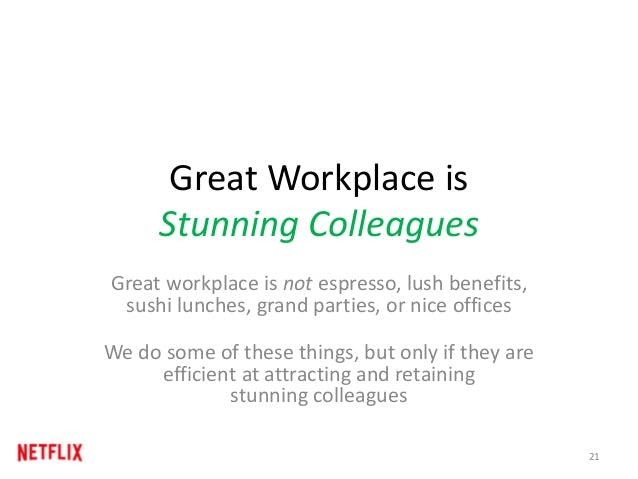

Adequate performers and free riders kill
Blockbuster passed away like many others due to the same reason: Normal performers and free riders. Normal teams tolerate those who perform on par with team average or below. And it kills them.
One weak teammate diminish team performance by 30-40% found professor . He compared performance for teams of college students — where a “bad apple teammate” actor was added to behave like a slacker, a jerk, or a pessimist.
Normal performance is infectious and magnify the which kills organisations. Adequate performers prefer to cover each other rather than to challenge each other to overachieve. To control and maintain performance of medium people and free riders, organizations build complex rules and bureaucracy at expense of creativity and agility. Vicious circle.
Fire average people and foster candor to enable creativity
Netflix’s managed to get out of this vicious circle. Their massive lay off of the average and below staff created the talent density. Reed found that talent density coupled with candid feedback solve the adequate performers and free rider problems. So less bureaucracy needed to control these two categories. Now company can afford Freedom for creativity guided by responsibility for mission and goals.
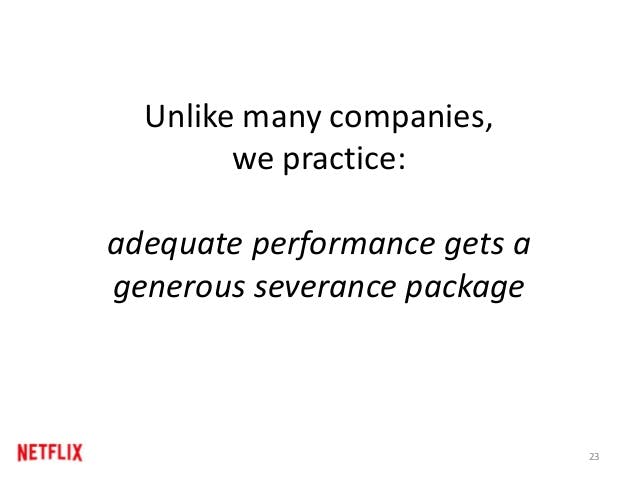

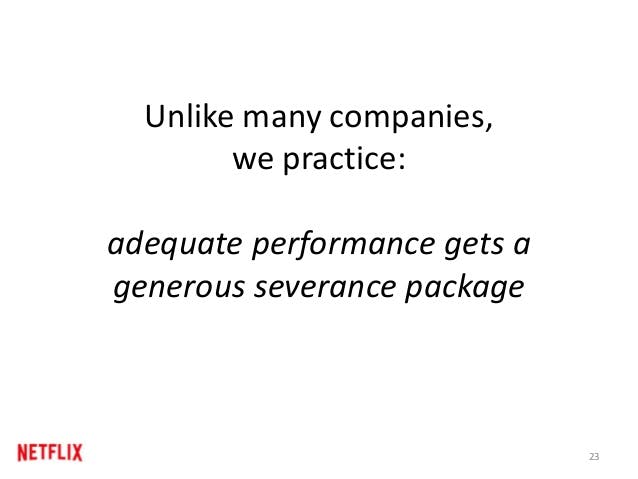
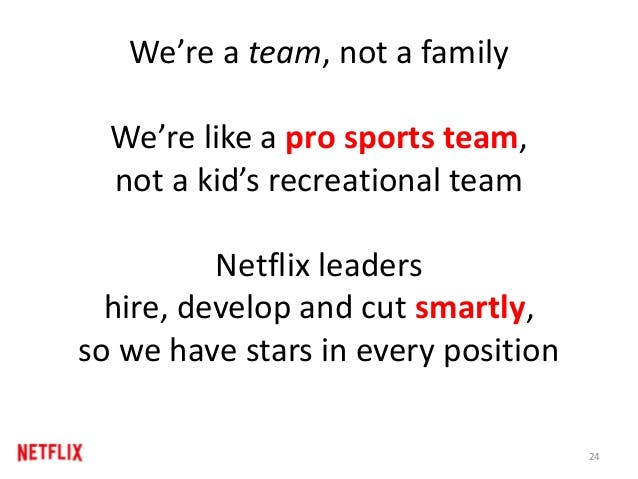






It was a scandal “do you treat average people like garbage you want to trash out to other companies”?
Other would argue, why would you put such harsh wording. Normal people should work in the companies of the past. That is normal and deserve respect. Fire with respect.
There were some scandals naming Steve Jobs as a jerk. He was cruel to embarrass employees and fired publicly for doubting that a task is doable. There were younger wartime companies cultures (outlined by Ben Horowitz 5 years later), and Zappos with their sweet family HR PR campaign.
Reed’s slides became shocking documentation of a real tech culture unexpected from a relatively large creative company.
Psychological safety is for the past
Harvard professors prayed for psychological safety as a must for creativity. The academic consensus was: Netflix culture can not exist in large organisations (the reason why tech companies and definitely startups avoid hiring MBAs).
Since then Netflix capitalisation grown 100x, Nasdaq 9x (tech), Dow Jones (traditional industries) 2.5x.




10 years after that scandal, Gary Pisano admitted at :
“Innovative cultures are generally depicted as pretty fun. When I asked the same managers to describe such cultures, they readily provided a list of characteristics identical to those extolled by management books: tolerance for failure, willingness to experiment, psychological safety, highly collaborative, and nonhierarchical.
The easy-to-like behaviours that get so much attention are only one side of the coin. They must be counterbalanced by some tougher and frankly less fun behaviors. A tolerance for failure requires an intolerance for incompetence. A willingness to experiment requires rigorous discipline. Psychological safety requires comfort with brutal candor. Collaboration must be balanced with individual accountability. And flatness requires strong leadership. Innovative cultures are paradoxical. Unless the tensions created by this paradox are carefully managed, attempts to create an innovative culture will fail.”


In 2009 the new cultural era was born. The goal of life “happiness” turned into goal of life “meaningfulness”. Which mean you must go out of comfort to grow and shift frontiers to create value. Otherwise you can not work in fast evolving tech companies. The companies which rule the planet today or tomorrow. These scandals and cultural change nurtured a scalable labour force able to build SpaceX.
Freedom and Responsibility
Freedom sucks without Talent density and Candor
In 1994 Reed Hastings found his sales manager billing his previous company with $3000+ ($700 in 1990x) for one hotel night. Instead of demonstrative firing he introduced rules to approve travel and accommodation. He made many other rules such as you need an approval if you come to office with a pet.
Today Netflix does not have any travel and vacation policy. No Rules Rule.
Reed warns: “Once you have build talent density, you can safely address candor. Only then can you safely began remove policies that control your staff.”
If you do not have talent density - addressing candor is risky. If you do not have Talent Density and Candor - Freedom will fail. Adequate performers with free riders will lower the bar and force top performers to quit. Adequate performers would help each other to protect their comfort and call jerks those who raise the bar. A players attract A players to grow. B attract C players to feel comfort as look adequate comparing to C. Fire B players or B will push A out in order to defend their comfort. Keep only top performers and establish candor to enable freedom and creativity.
Build the Culture of Freedom and Responsibility:
Step 1. Build Talent Density: Great work place is Stunning Colleagues. Top performers should hire top performers challenging each other to overachieve and fire adequate performers who prefer to cover each others mediocracy. When achieved - build candor.
Step 2. Build Candor: Say what you really think, especially negative feedback, - with positive intent. No backtalk. Fire for backtalk or for failure to report backtalk.
Only if you have 1+2 move to:
Step 3. Reduce Controls and Bureaucracies: Growth of top performers should exceed growth of complexity. Top performers should be disciplined and have freedom to be creatively focused on clear goals and strategy.
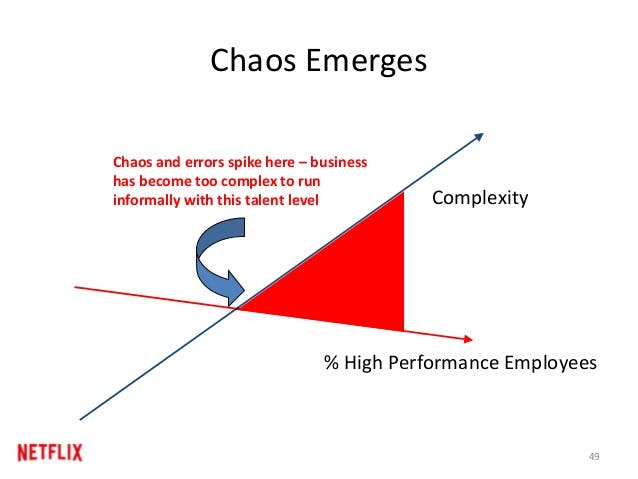



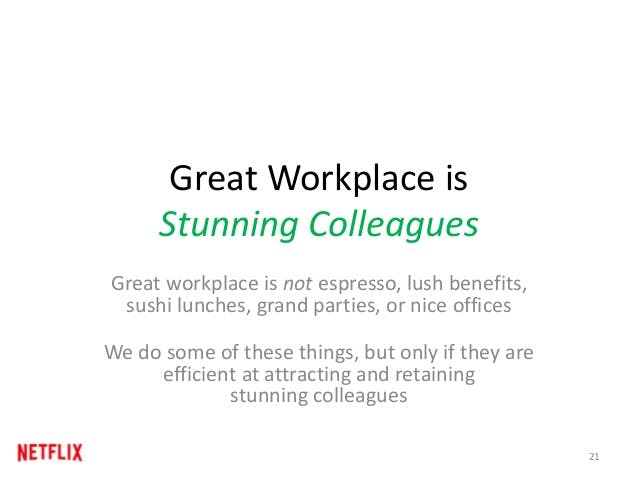

Do you plan to be a top performer or an adequate performer?
It is easy to check. How did you : Did you read a top book in your profession, implemented a no code tool or had a small talk with adequate friends?
spend this weekend
Commitment to spread the responsible visionary achiever culture
Learnings
Learnings
I will read top books from top CEOs and never kill time with mediocracy
I will read/listen the book No Rules Rules of Netflix shortlisted by Financial Times /McKinsey as a business book of 2020
I will hire top performers and fire adequate performers
I will be brutally candid and collaborative to boost team performance
I will protect interests of clients and LATOKEN to build freedom for creativity
I will ensure strategy and goals are clear to enable freedom for creativity to hit targets
There are no rows in this table


Related reading:
Want to print your doc?
This is not the way.
This is not the way.

Try clicking the ⋯ next to your doc name or using a keyboard shortcut (
CtrlP
) instead.